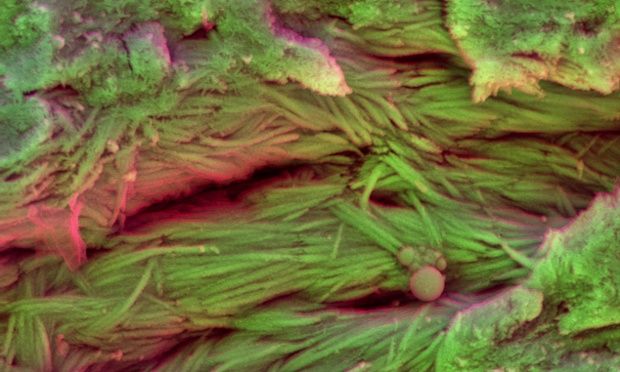
Scientists at the Imperial College in London have found red blood cells and collagen fibres in the fossilised remains of dinosaurs that lived in Canada 75 million years ago.
The find could mean that dinosaur fossils in museums around the world may also contain soft tissues, possibly even DNA, which would allow scientists a chance at better understanding the evolution and physiology of dinosaurs.
Theguardian.com reports:

BYPASS THE CENSORS
Sign up to get unfiltered news delivered straight to your inbox.
You can unsubscribe any time. By subscribing you agree to our Terms of Use
Most of the fossils the scientists studied were mere fragments and in very poor condition. They included a claw from a meat-eating therapod, perhaps a gorgosaurus, some limb and ankle bones from a duck-billed dinosaur, and a toe bone from triceratops-like animal.
Intact soft tissue has been spotted in dinosaur fossils before, most famously by Mary Schweitzer at North Carolina State University, who in 2005 found flexible, transparent collagen in the fossilised leg of a Tyrannosaurus rex specimen.
Advertisement
What makes the latest discovery so remarkable is that the blood cells and collagen were found in specimens that the researchers themselves describe as “crap”. If soft tissue can survive in these fossils, then museum collections of more impressive remains could harbour troves of soft dinosaur tissue. Those could help unravel mysteries of dinosaur physiology and behaviour that have been impossible to crack with bony remains alone.
“It’s really difficult to get curators to allow you to snap bits off their fossils. The ones we tested are crap, very fragmentary, and they are not the sorts of fossils you’d expect to have soft tissue,” said Susannah Maidment, a paleontologist at Imperial.
The fossils are a smattering of pieces collected last century, probably directly from the ground, at the Dinosaur Park Formation in Alberta, Canada. To analyse the remains, the scientists broke tiny pieces off the fragments to expose fresh, uncontaminated surfaces inside.
Sergio Bertazzo, a materials scientist at Imperial, had been working on the build up of calcium in human blood vessels when he met Maidment and asked if he could study some fossils with an array of electron microscope techniques.
Months after the specimens arrived, Bertazzo began to look at thin sections of the fossils. He began with the therapod claw. “One morning, I turned on the microscope, increased the magnification, and thought ‘wait – that looks like blood!’,” he said.
Bertazzo suspected the blood was historic contamination: a curator or a collector had a cut when they handled the speciment. But Maidment suggested a check. Mammals are unusual among vertebrates in having red blood cells that lack a cell nucleus. If the fossil’s blood cells had nuclei, they could not be human. When they sliced through one of the cells to check, they saw what looked like a nucleus. “That ruled out someone bleeding on the sample,” said Maidment.
Another surprise was to come. Bertazzo was examining another fossil fragment, a piece of rib from some unidentified dinosaur, which had been sliced in two inside the microscope. He spotted bands of fibres, which further tests found to contain amino acids known that make up collagen, the protein-based material that forms the basis for skin and other soft tissues.
More work is needed to be sure the features are genuine blood cells and collagen. The scientists now hope to scour more fossils for soft tissues, and then work out what sorts of burial and environmental conditions are needed for their preservation.
“It may well be that this type of tissue is preserved far more commonly than we thought. It might even be the norm,” said Maidment, whose study appears in Nature Communications. “This is just the first step in this research.”
A detailed study of the soft tissues could unravel some of the long-standing mysteries of dinosaur evolution. The dinosaurs evolved from cold-blooded ancestors, but their modern descendants are warm-blooded birds. When did the transition occur? Red blood cells may hold the answer.
If collagen and red blood cells can survive for 75 million years, what about dinosaur DNA, bearing the genetic code to design, or potentially even resurrect, the beasts?
“We haven’t found any genetic material in our fossils, but generally in science, it is unwise to say never,” said Maidment. Bertazzo is hedging his bets too: “This opens up the possibility of loads of specimens that may have soft tissue preserved in them, but the problem with DNA is that even if you find it, it won’t be intact. It’s possible you could find fragments, but to find more than that? Who knows?”
Anjali Goswami, a paleontologist at University College London, said that if dinosaur soft tissues were found in many more fossils, it could have a transformative effect on research. “If we can expand the data we have on soft tissues, from fossils that are poorly preserved, that has real implications for our understanding of life in deep time,” she said.

Be the first to comment